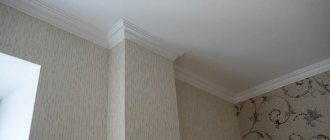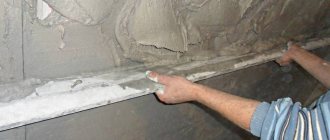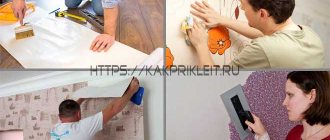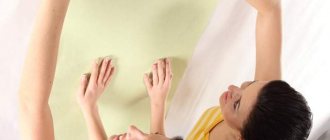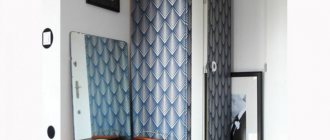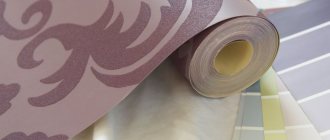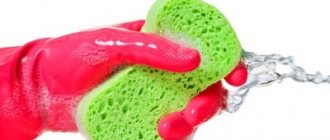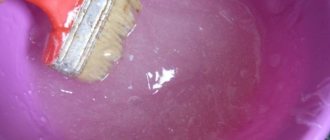How long does it take for wallpaper to dry?
Drying time is usually determined by the type of finishing materials. Products with a paper base require the least amount of time. When using them, windows can be opened without problems after a day. The time increases to 36-48 hours in the case of non-woven materials. The premises must remain closed until the specified time has ended.
Adding a non-woven backing to vinyl increases drying time. Then the process takes from 3 to 7 days. It is recommended to avoid forced drying, as this will spoil the results. Otherwise, you won't be able to glue anything.
Gluing non-woven wallpaper for painting requires special care. They are given at least a week before starting the next stage of work. Non-woven wallpaper is generally an expensive type of material, so responsible work is mandatory. This is one of the answers to the question of when you can open a window after wallpapering.
Gluing non-woven wallpaper for painting requires special care.
Should the windows be opened or closed when wallpapering?
When it comes to whether to open windows to dry wallpaper or not, you can hear the most conflicting opinions. Most people think that this should not be done. Here are some reasons why:
- The wallpaper should dry evenly. This cannot be achieved with an open window. The same goes for heaters and fans. It is best for the glue to be absorbed “on its own,” gradually penetrating deep into the wall, rather than drying on the surface itself.
- Temperature changes should not be allowed - paper products react poorly to such treatment. Ultimately, even if the wallpaper dries, mold may appear.
- Cold air leads to uneven covering of the wall and the appearance of “bubbles”. We'll have to do it all over again.
However, all the precautions arose precisely when the market was flooded with cellulose-based products. Indeed, paper wallpaper does not tolerate high humidity and sudden temperature changes very well. But in modern stores you can find no less successful analogues - for example, non-woven or vinyl-based wallpaper.
True, some non-woven wallpaper can be sensitive to temperature changes. It is recommended to check this with the manufacturer in advance.
In general, non-woven wallpaper takes longer to dry than paper wallpaper, but is not as susceptible to peeling off. Experts note that failures with non-woven materials are not a consequence of improper drying, but a violation of wallpapering technology. On average, it will be possible to open windows after wallpapering within 2 days.
Why can't you open windows?
The answer is to prevent the situation with rapid drying of the glue. Otherwise, the materials peel off from the surface, and it becomes necessary to additionally trim the joints. Paper and non-woven materials cause the most problems. All types of substrates suffer from defects if the temperature changes too sharply. The premises must remain closed for at least 2-3 days. Another question is whether it is possible to glue wallpaper with the window open.
The premises must remain closed for at least 2-3 days.
Rules for drying non-woven and vinyl-based wallpaper
Non-woven fabric and vinyl are much denser than paper rolls, so windows after gluing such rolls cannot be torn off for longer (5-6 days). What happens if you break this rule?
- Non-woven fabric and vinyl are moisture-resistant materials; they do not absorb moisture well, so it can be assumed that they do not get wet during the application of the adhesive. This means that the drying time should not increase. What's really happening?
- Non-woven and vinyl wallpaper is a heavy material; in order to ensure reliable adhesion to the wall surface, it is necessary to use a larger amount of glue. The adhesive composition is applied to the wall. It is partially absorbed into its surface, a wet wall takes longer to dry, which is why, when answering the question of how long windows should not be opened after hanging vinyl or non-woven wallpaper, experienced painters recommend waiting for five days or even more.
- Since the top non-woven layer is not afraid of moisture, it dries much faster than the inner one. That is why minor temperature changes are unable to cause deformation of the canvas. This explains why such canvases can be glued with open windows. But a successful experience will only happen in the summer. In other weather seasons, it is imperative to close all the doors and doors.
Note! Most often, problems with vinyl and non-woven wallpaper arise not due to violations of drying conditions, but due to incorrect technique for gluing heavy canvases.
And one more important circumstance. It is forbidden to carry out other repair work while the wallpaper is drying, even with the windows closed. And all because almost all of them, one way or another, affect the quality of the expected results. For example, during the installation of suspended ceilings in a room, the air temperature from a heat gun rises greatly, which negatively affects the described processes. When drilling walls on which the wallpaper has not yet dried, unsightly holes with torn edges are formed. You cannot glue them, as the weight of the double glue will definitely peel off the sheets.
Glue drying period
This is another factor that needs to be taken into account. Quick-drying type compounds are often found on the market. But there are some recommendations here too:
- 36 hour exposure;
- In some cases, a gap of two days is required. Why you can glue through this gap has already been written earlier.
In some cases, a gap of two days is required.
How long does it take for wallpaper to dry?
The average duration will be 24-48 hours, but there are some nuances.
The average duration will be 24-48 hours.
Paper wallpaper
The drying process is the fastest, but even such conditions do not require the use of special types of equipment. On average, drying takes 12 hours, no less. Paper always requires this time.
The drying process is the fastest, but even such conditions do not require the use of special types of equipment.
Non-woven wallpaper
Manufacturers recommend leaving the material alone for at least a day, in most cases the time increases by 2-3 days. Specific numbers depend on the company that released the composition. Sometimes this rule also applies to paper composition.
Manufacturers recommend leaving the material alone for at least a day, in most cases the time increases by 2-3 days.
Vinyl wallpapers
The drying time here is much longer compared to paper counterparts, but there are not so many environmental requirements. A minimum of 24 hours is required, but most manufacturers require 4-5 days. Spring is no exception.
A minimum of 24 hours is required, but most manufacturers require 4-5 days.
Paper wallpapers and their advantages
For many decades, paper wallpapers have been the most popular. There were no difficulties with gluing them. The only inconvenience is that such material takes a long time to dry; it should be carefully smoothed to remove air. Any draft or sudden temperature change disrupts uniform drying, the canvas swells, becomes deformed, and it is possible that it will come off the wall. Therefore, it is customary not to open the windows during pasting and until the wallpaper is completely dry.
To ensure high-quality wall coverings with paper wallpaper, it is recommended to adhere to the following rules:
- At normal air temperatures, paper-based canvases require half a day to dry. But for complete drying, you should not open the windows for two days.
- Exposure to a fan or air conditioner also has a negative impact on the quality of the coating. Their air currents do not allow the canvas to dry evenly. Heaters are also not advisable, since they will not be able to heat the air equally over the entire height of the wall.
- You should not change the air humidity in the room in any way. Glue fumes increase humidity. The room will be stuffy, but this will help the wallpaper dry evenly.
Tip: To make sure that the paper wallpaper has dried well, just try it with your hand. If the canvas is dry, wait a few more hours without airing, just to be on the safe side.
Requirements for the room microclimate
Drying is perfect at 18 degrees. But you don’t need to think about using and installing air conditioners that additionally control the microclimate. The process proceeds normally even at 20-30 degrees. This requirement must be taken into account when it comes to preventing too rapid ventilation. Including when vinyl material is used.
Do not forget about humidity, whose standard value is in the 60% limit. At a higher level, acquiring the required form takes more time.
Deformation of adhesive bases also occurs when the temperature drops. Instantaneous evaporation of the water part occurs. It is recommended to use a spray bottle before starting work; a possible negative consequence if the conditions are not met is peeling.
It is recommended to avoid black materials that absorb heat too actively. The area of the room also affects how quickly the work is completed. And how much ventilation should be done so that a draft does not form.
Drying is perfect at 18 degrees.
What is there not to worry about?
No need to worry about an open window in the neighboring rooms. They can be ventilated during repairs. Also, you should not be in a stuffy room when hanging vinyl and non-woven wallpaper. During drying, they react to a draft, however, in the absence of one, an open window will not harm.
You should not restrain your movements for fear that the air currents from flapping your arms will damage the wallpaper. They only react to a constant draft. You should carefully exit and enter the room. In this case, the door must be opened slowly.
Do not wait an additional 2 days after drying. If the room is stuffy, you should open the window. This will have a positive effect on your health, because prolonged stay in a stuffy room negatively affects brain function.
If you start gluing wallpaper in the morning, then the next day you won’t have to worry about open windows and doors.
When to open the window
The question does not have a clear answer. The numbers for a specific case are directly related to the types of glue and wallpaper. You need to study the rules that have already been mentioned above. Manufacturers provide additional recommendations on their part.
When planning other finishing work, it is better not to start the next steps until the previous layers have dried completely. An example is the change in room temperature when using suspended ceilings. Painting a surface often results in materials peeling off if important steps are delayed.
When planning other finishing work, it is better not to start the next steps until the previous layers have dried completely.
Is it possible to enter the room
The doors inside the room do not need to be kept closed for 24 hours. Only a specific room requires tight shutters for door and window openings. In other rooms, elements that are wide open will be useful, even necessary. The temperature will change, but such adjustments will not be enough to worsen the result.
The stripes are damaged only by strong drafts and winds that continued to blow for several hours. Therefore, it is still necessary to close the structures. Non-woven wallpapers are more vulnerable to the environment, so extreme care is taken with them.
Floor and ceiling skirting boards will help you cope if problems do arise. If you choose the right shades, they will not only support the structures, but also decorate the appearance of the room.
Floor and ceiling skirting boards will help you cope if problems do arise.
Uneven drying of the fabric
If glued wallpaper dries unevenly, it may wrinkle and stains may remain on the walls.
Therefore, you need to make sure that the windows and doors are tightly closed, and the drying process occurs under natural conditions.
This applies to all types of wallpaper, the only difference is the length of time it takes for them to dry. In addition, you can ventilate the room in which the wallpaper was hung only a day after completion.
Is it possible to turn on the fan?
This is strictly prohibited, especially to speed up the process. The hot air flow increases the rate at which water evaporates from the adhesive layer. Uneven drying occurs and materials peel off. A closed perimeter of the room always works better.
The hot air flow increases the rate at which water evaporates from the adhesive layer.
What can you do while drying wallpaper?
You can go inside the room by opening the doors from time to time. But if possible, it is recommended to exclude situations with regular acceleration of air masses. Not only is it acceptable to stay inside the papered rooms for some time, simple passages are not prohibited. Doors with windows in other rooms can be opened.
Additional drying tips
The following factors are unacceptable:
- Air conditioning operation;
- Temperature adjustments in different directions;
- Drafts, harmful at different times of the year. It doesn't matter whether it's summer or winter.
Heating lighting can be used only to speed up drying between wall surfaces and canvases.
You can go inside the room by opening the doors from time to time.
It is necessary to get rid of any traces on the surface:
- Wallpaper;
- Old glue;
- Dye.
The bumps and small cracks are being sealed and the holes are being puttied. You need to wait for the putty itself to dry, then take fine sandpaper to sand the surface.
The walls are also carefully cleaned of dust and dirt; in some places it is permissible to use a vacuum cleaner. Applying a primer promotes better adhesion. Purchased wallpaper glue is suitable for making finishing materials yourself. Compared to the second component, you need twice as much liquid to make gluing everything easier.
The main thing is to coat the wall carefully, avoiding any gaps. Otherwise, from above and below, along the joints, the likelihood of peeling increases. The quality of surface priming affects how well materials adhere to the surface. It is not so difficult to stick the material onto a surface with high quality.
Primer mixtures have the following advantages:
- Give uniform properties even to surfaces with different compositions;
- Improve adhesion or adhesion index;
- Strengthens the foundation. Pasting comes later.
Applying a primer promotes better adhesion.
Base materials affect drying time:
- 5-20 minutes for glyphthalic compounds;
- For alkyd – 10-15 hours;
- Up to 5 hours if you have acrylic. Autumn does not change this figure.
Working with the results is strongly determined by room temperature and porosity. Most primer mixtures dry normally at a positive temperature of 25 degrees, if nothing is exposed frequently.
Accelerating drying is also prohibited in this case, regardless of the chosen methods and finishing options. The primer also falls under this rule. Uneven joints and deformation of strips, fragments of materials moving away from the wall - these are just some of the troubles encountered when the rules are violated. Because of this, the base deteriorates.
Accelerating drying is also prohibited in this case, regardless of the chosen methods and finishing options.
Rules for drying wallpaper appeared when such technologies in construction were just beginning to develop. But they still remain relevant, because there is no way yet to circumvent such properties and the consequences of violating the requirements. Manufacturers guarantee the safety of materials only under conditions that are fully observed. It is possible, sometimes even necessary, to enter the premises during drying. But it is not recommended to keep the air flow moving for too long. Deliberate violation of these rules also only leads to negative consequences and the need to repeat the work, which is associated with additional expenses.
Preparing the walls
When preparatory work for gluing is underway, the windows are not only possible, but also necessary to be kept open.
It is necessary to clean all surfaces of former coatings - wallpaper, old glue or paint, fill cracks, remove all bumps on the walls. The putty must dry completely, after which the surface must be sanded with fine sandpaper.
Clean the walls from dust by brushing or collecting it with a vacuum cleaner. After this, apply a primer. It provides better adhesion of wallpaper to the wall. You can prepare the primer yourself from purchased wallpaper glue. It must be diluted with water, taking two to three times more liquid than for preparing the adhesive solution.
It is necessary to coat the wall thoroughly, without skipping, otherwise the wallpaper may peel off at the joints, top or bottom, or the entire canvas may peel off. How well the wallpaper will stick to the wall depends on a well-primed surface.
You can check whether the walls are properly prepared and how well they are prepared in a simple way: you need to cut a strip of electrical tape and stick it on the wall. If, when removed, no small particles of plaster remain on the tape, then the surface is ready. Wallpapering walls should only be done on completely dry walls.
What happens if you open the windows immediately after wallpapering is shown in the photo:
Recommended Posts
Yellow wallpaper in the interior of the living room, kitchen, bedroom and nursery
How to quickly paste wallpaper
How long does liquid wallpaper take to dry?
How to glue wallpaper on plaster
How to join wallpaper correctly
How to get rid of mold on wallpaper
Comments
- I glue with the windows and doors closed, I mean vinyl wallpaper, well, as usual, but I open it slowly and there were no problems at all and with good quality
Tatyana07/17/2018 at 22:22
Answer
